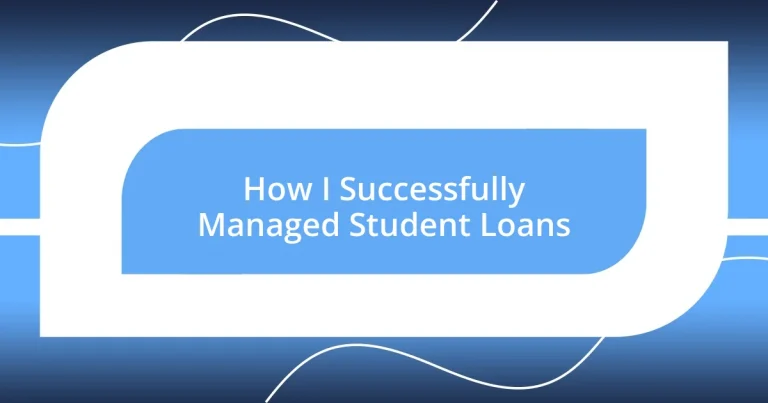Key takeaways:
- Understanding the details of student loans, including types and repayment plans, is essential for informed financial decisions.
- Implementing a structured budgeting strategy, like the 50/30/20 rule, and revisiting it regularly enhances financial control and adaptability.
- Proactively managing payments, utilizing loan forgiveness options, and monitoring progress allows borrowers to take ownership of their financial journey and reduce debt effectively.
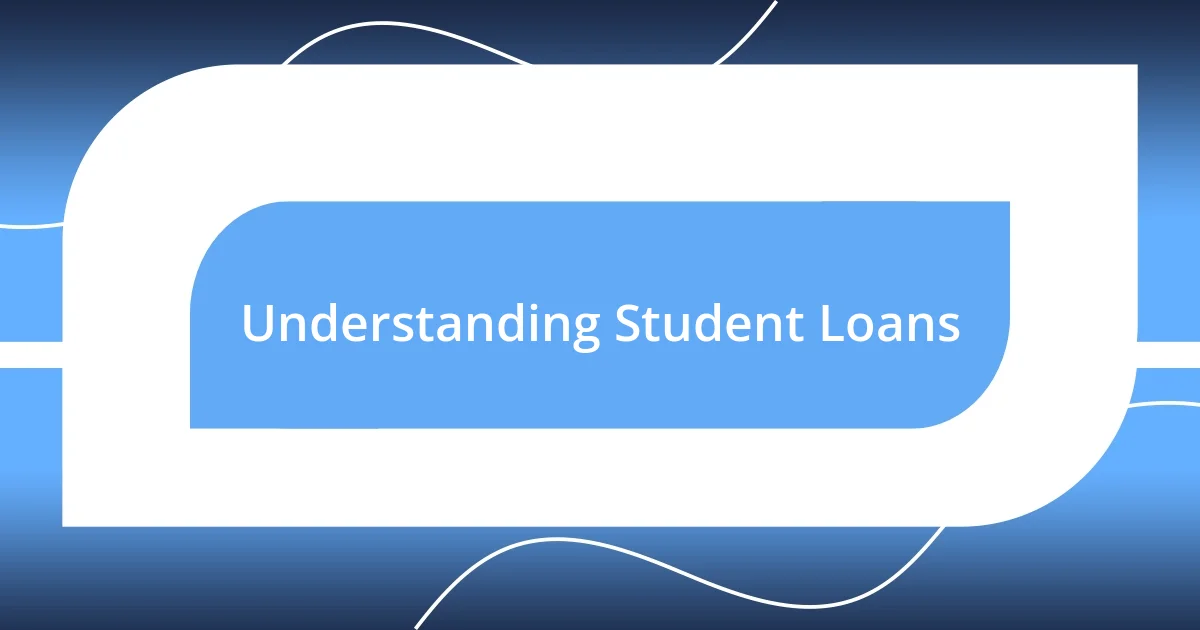
Understanding Student Loans
Understanding student loans is crucial because they can shape your financial future for years to come. I still remember the day I signed my loan paperwork; it felt like a weighty decision that would follow me long after graduation. When you’re handed that stack of documents, have you ever wondered what it all really means for your long-term financial health?
Each loan type—federal or private—comes with its own intricacies that can be quite daunting. I chose a federal loan because I was attracted to the lower interest rates and the choice of repayment plans. Imagine receiving a complex loan agreement with a ton of jargon—terms like “capitalization” and “subsidized interest.” It can be overwhelming, right? Understanding these definitions is essential to make informed decisions about repayment.
One thing I learned through experience is that managing student loans isn’t just about repayment schedules; it’s also about budgeting and planning for the unexpected. There were months that felt particularly tight, and honestly, I often found myself stressed about affording my payments. By reflecting on those moments, I realized that proactively creating a flexible budget helped me feel more in control of my finances. Isn’t it fascinating how our experiences with money can shape our perceptions of stability and security?
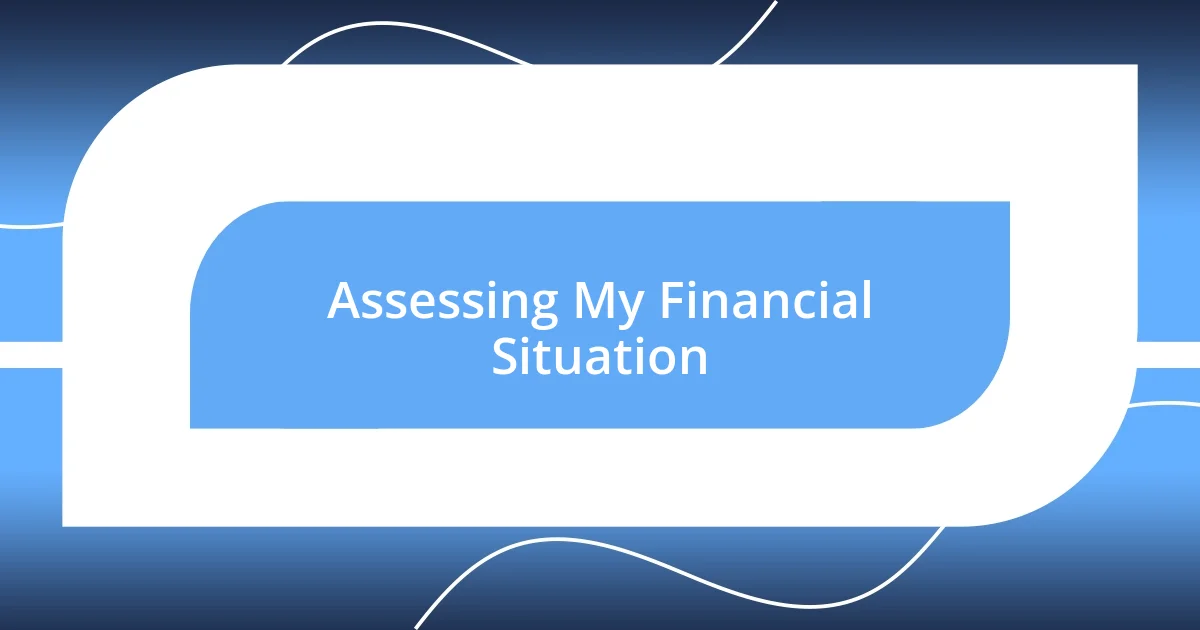
Assessing My Financial Situation
Assessing my financial situation was an eye-opening experience. I recall sitting down with my latest bank statement and feeling a mix of anxiety and determination. It was crucial to take stock of my income, expenses, and debts. I developed a clearer picture of my financial landscape, which enabled me to strategize more effectively.
Here’s what I focused on during my assessment:
– Income: I calculated all sources—part-time job, savings, and any side gigs.
– Expenses: I tracked every dollar, from rent to the smallest subscription services.
– Debt: I listed my loans, noting interest rates and monthly payments.
– Emergency Fund: I assessed whether I had enough saved for unexpected expenses.
– Financial Goals: I set short-term and long-term goals to guide my budgeting.
By mapping everything out, I felt empowered to tackle my challenges, turning what felt like a heavy burden into manageable steps. I discovered budgeting apps that simplified this process, allowing me to interact with my finances more visually, which relieved some of that financial anxiety.
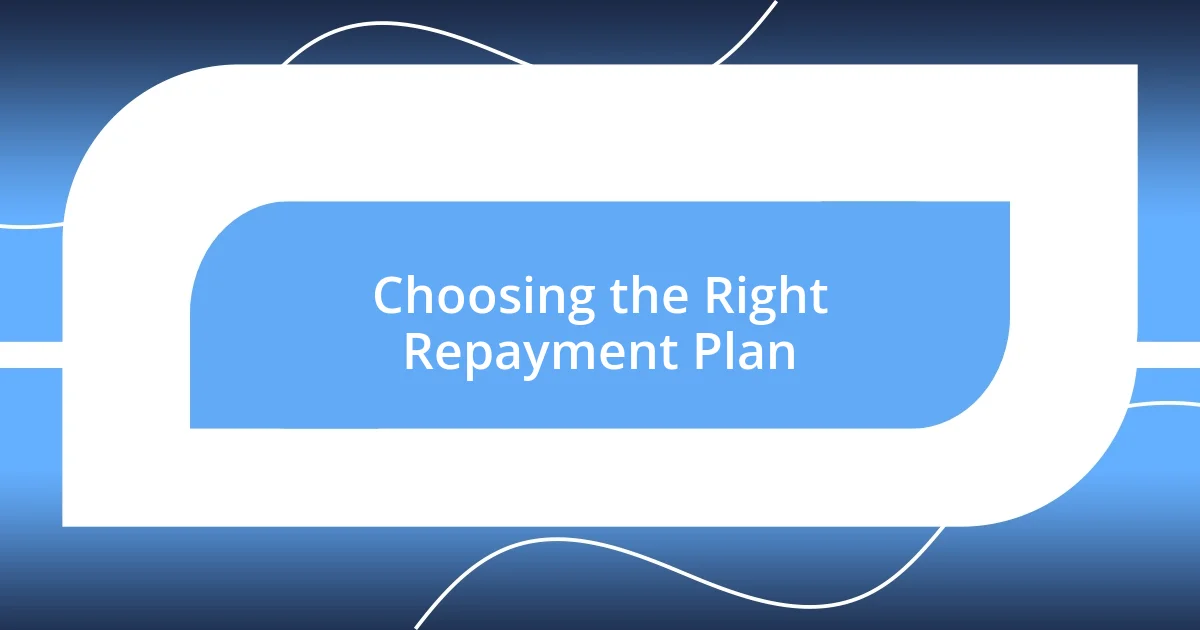
Choosing the Right Repayment Plan
Choosing the right repayment plan can significantly impact your financial journey post-graduation. I remember feeling overwhelmed by the various options available, from standard plans to income-driven repayment avenues. The first time I looked through the choices, I felt like I was standing in a candy store with a million flavors, unsure which one was right for me. It’s crucial to consider not just the monthly payment but also how it fits into your overall financial picture.
When I narrowed my options, I realized that an income-driven repayment plan aligned best with my fluctuating income as a recent grad. I often had a tight budget, and knowing that my payments would adjust based on my earnings brought me immense comfort. It was like a safety net during a time of uncertainty. Plus, I learned that these plans could even extend the repayment term, making those monthly amounts feel less daunting in the short term. Just imagine having the flexibility to breathe a bit easier while you find your footing in your career!
In my experience, the key to choosing wisely lies in understanding how each plan works and what it entails for your future. For instance, some plans can forgive your remaining balance after a certain period, which can be a fantastic relief. As I explored the details, I made a comparison table to visualize my options better. This helped me weigh the pros and cons, ensuring I didn’t overlook any essential factors that could affect my financial health down the line.
| Repayment Plan | Description |
|---|---|
| Standard Repayment | Fixed monthly payments over 10 years. Best for those who want to pay off loans quickly. |
| Income-Driven Repayment | Payments based on income, with potential forgiveness after 20-25 years. Suitable for low-income graduates. |
| Graduated Repayment | Lower payments initially that increase every two years. Good for those expecting higher future earnings. |
| Extended Repayment | Fixed or graduated payments over up to 25 years, lowering monthly payments. Ideal for those needing long-term relief. |
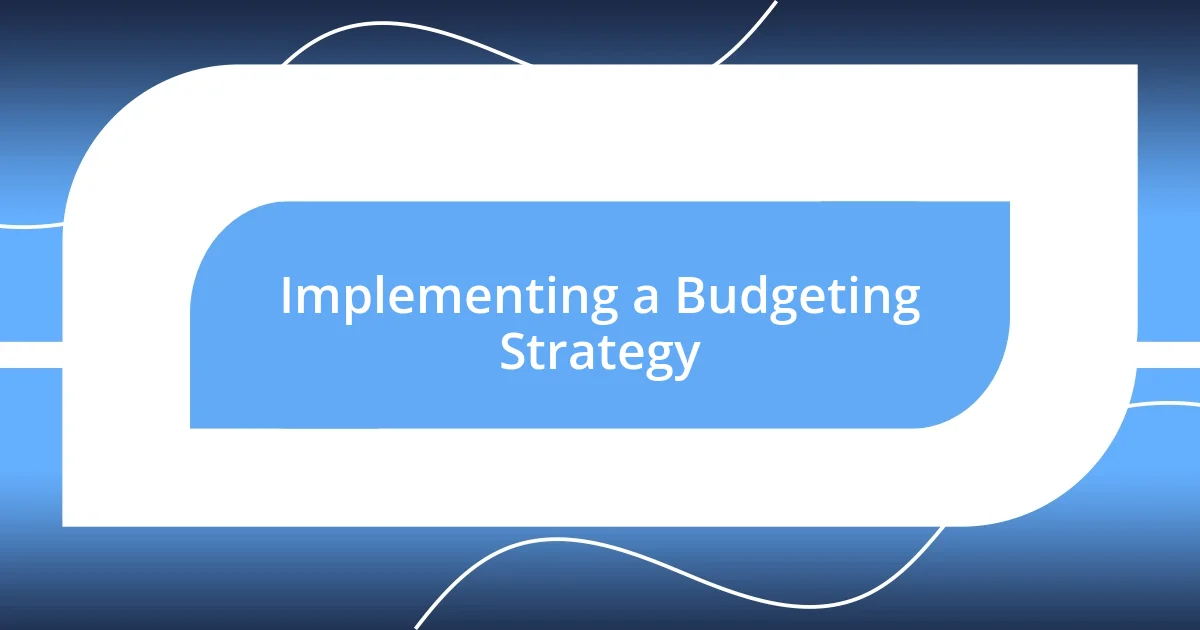
Implementing a Budgeting Strategy
Implementing a budgeting strategy was a game-changer for me, especially when I discovered the power of prioritizing my expenses. I still remember the moment I categorized my spending into “needs” and “wants.” By visually separating essential costs like rent and groceries from discretionary spending, I regained control and clarity over my finances. Isn’t it amazing how just a small shift in perspective can make budgeting feel less like a chore and more like a personal commitment to my future?
One effective approach I found was the 50/30/20 rule, where I allocated 50% of my income to necessities, 30% to lifestyle choices, and 20% to savings and debt repayment. This simple guideline transformed how I viewed my cash flow and helped me set realistic spending limits. I vividly recall the satisfaction of watching my savings grow each month, reinforcing my resolve to stick to the plan. Have you ever experienced that rush of excitement when achieving a financial goal? It’s invigorating!
In my journey, I also learned the importance of regularly revisiting and adjusting my budget. Life is unpredictable, and there were months when unexpected expenses cropped up, like car repairs or medical bills. During those times, I was reminded of the value of flexibility. By routinely assessing my budget and making necessary tweaks, I could navigate those bumps in the road with confidence, ultimately keeping my student loans manageable. It turned budgeting into a dynamic process, rather than a rigid set of rules. Doesn’t it feel empowering to adapt rather than be trapped by your own plans?
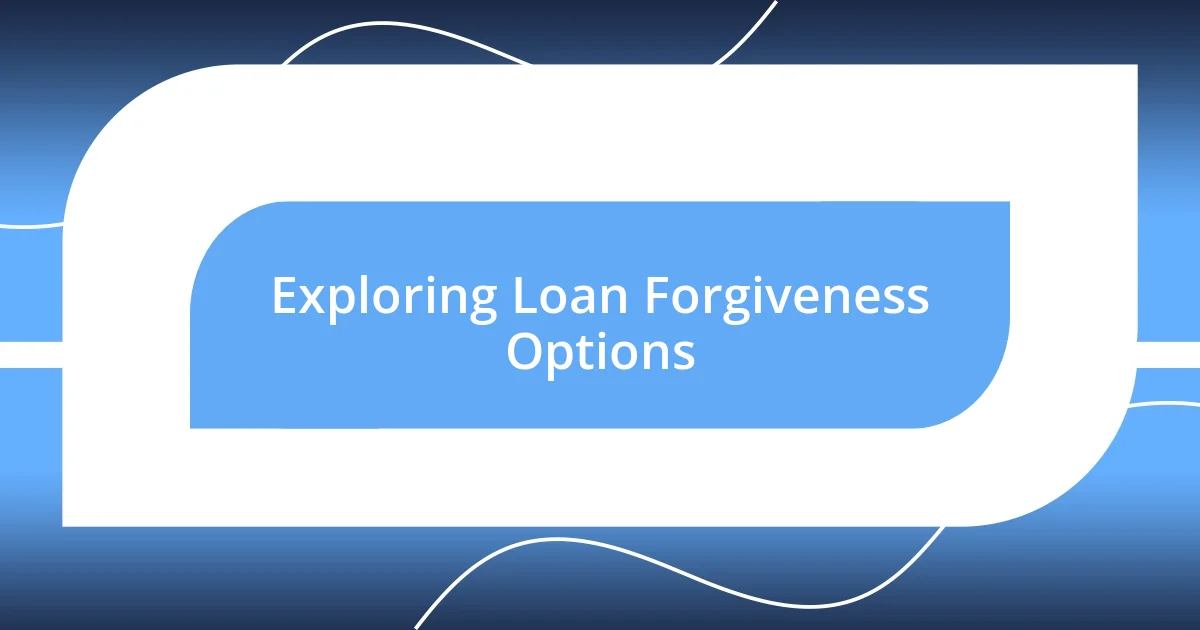
Exploring Loan Forgiveness Options
Exploring loan forgiveness options can seem like a maze, but it’s a crucial path worth navigating. When I first learned about Public Service Loan Forgiveness (PSLF), it felt almost too good to be true. Working in a nonprofit, I could have my loans forgiven after 10 years of qualifying payments. Just imagine the weight that could lift off my shoulders! I remember the moment I realized this option was available for people like me—suddenly, my monthly payments no longer felt like a lifetime sentence.
Beyond PSLF, I discovered that some income-driven repayment plans offer forgiveness after 20 to 25 years, which was a light at the end of the tunnel. I often found myself questioning if I’d ever escape my student loan debt, but knowing that I might get relief after a couple of decades gave me hope. It made me reflect on my career choices and consider how I could serve my community while also advancing my financial goals. Have you thought about how your job might align with these forgiveness programs? It’s an exciting prospect, merging personal growth with financial freedom.
As I delved deeper into the subject, I met peers who were also exploring these options, and it made the journey feel less daunting. Sharing our stories and understanding the eligibility requirements together reinforced the importance of staying informed. I found myself asking questions like, “What documentation do I need?” or “How do I ensure I’m on track for forgiveness?” These conversations not only educated me but also created a support system that helped us all navigate our own paths toward loan forgiveness. Engaging with others can transform what feels like an overwhelming process into a community effort, turning burdensome debt into shared victories.
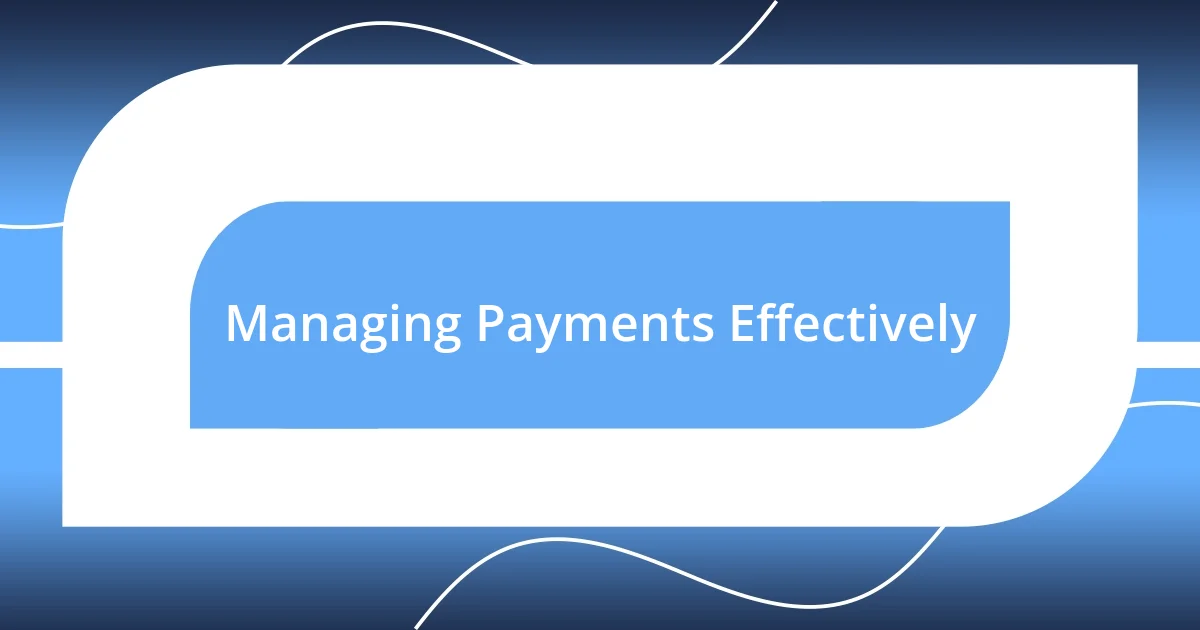
Managing Payments Effectively
Managing payments effectively required me to take a proactive approach. I recall setting up automatic payments for my loans right after payday. This simple strategy transformed my relationship with my debt; it felt like I was prioritizing my financial health, rather than letting payments slip through my fingers. Have you ever thought about how easy it is to forget these payments when life gets busy? Trust me, having that system in place delivered peace of mind.
I also learned the importance of creating an extra payment schedule whenever I had some surplus funds. I distinctly remember the thrill of applying a tax refund toward my student loans—reducing my balance felt like a mini-victory. It’s amazing how each small win can motivate you to keep going. Do you have a plan for using unexpected incomes to chip away at your debt? I’ll tell you, those additional payments made a significant difference over time, shortening my loan term and reducing the interest I paid.
Finally, I can’t stress enough the power of staying informed about interest rates and payment options available to me. Early on, I reached out to my loan servicer to discuss potential refinancing. I still remember my shock when they explained how a lower interest rate could save me hundreds of dollars in the long run. It made me wonder why I hadn’t sought this information sooner. Being proactive and asking the right questions not only empowered me, but it also introduced avenues for financial relief that I hadn’t considered before. Have you tapped into the resources available to you? Don’t hesitate—knowledge is a powerful tool in managing your student loans effectively.
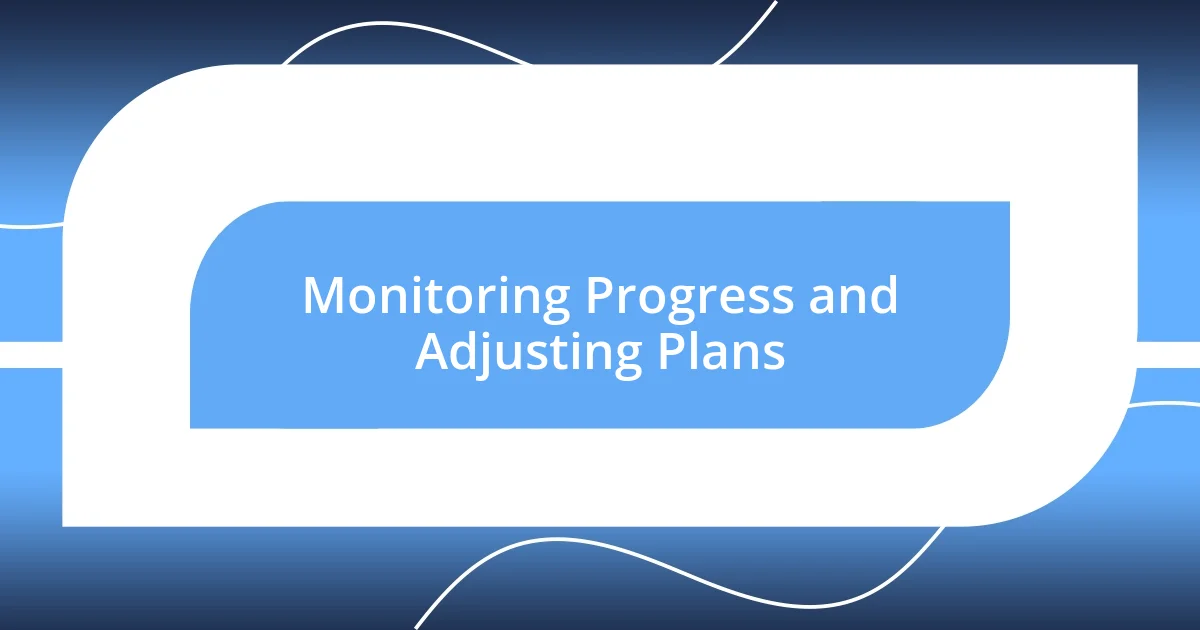
Monitoring Progress and Adjusting Plans
Monitoring my progress on student loans was a game-changer. I often took time each month to review my statements and assess how my payments were impacting my overall debt. It was eye-opening to see the numbers decline, but I also realized that I needed to adjust my plan when life threw me curveballs, like unexpected expenses. Have you ever felt overwhelmed by financial surprises? I know I did, but recognizing the need to adapt helped me stay on track.
One pivotal moment came after I hit a financial snag when my job shifted to part-time. I had to recalibrate my repayment strategy, choosing to temporarily switch to an income-driven repayment plan. This choice not only flipped my stress into a manageable relief but also reignited my determination to get back to full-time work. How do you handle unexpected changes in your financial situation? Engaging in this reflective process helped me see that flexibility is as necessary as having a solid plan.
Sorting through my financial choices didn’t just help me manage my loans; it created a sense of ownership in my journey. I remember celebrating small milestones, like reaching a loan balance under $10,000 or making my 24th consecutive payment. These achievements motivated me to continue adjusting my plans as I learned more about repayment options and interest rates. What motivates you to stay committed to your financial goals? Connecting these personal wins to my broader objectives fostered a mindset that empowered me to keep moving forward, no matter the challenges ahead.












